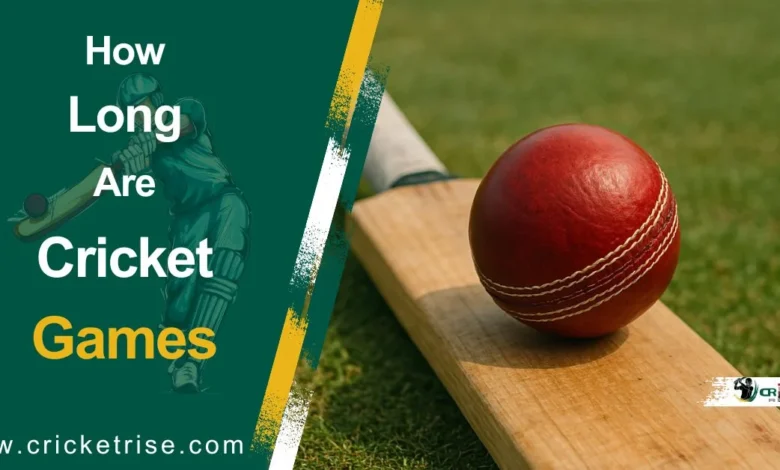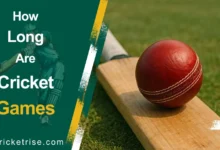How Long Are Cricket Games: The Real Rhythm Behind the Game

How Long Are Cricket Games? A sport rich in tradition and nuance often invites curiosity not only because of its intricate rules but also due to the unique time it demands. Whether you’re watching a quick-fire contest under bright floodlights or a grand multi-day saga unfolding over several sessions, one question always lingers: how long are cricket games? This question, seemingly simple, opens the door to a broader exploration of culture, structure, and style within the sport.
The beauty of cricket lies in its many forms. Each format brings its own tempo, rhythm, and expectation. From grassy club fields to international arenas, the timeline of a cricket match often reflects the very soul of the format being played. Understanding how long cricket games are is more than just keeping track of hours; it’s about appreciating the deeper mechanics and the unspoken poetry of the game.
The Evolution of Time in Cricket
The idea of time in cricket has evolved just as the game itself has. In the early days, matches were leisurely affairs. Teams would meet with no thought of hurrying, often taking extended breaks for meals, chats, and even the occasional nap under a tree. The query of how long are cricket games didn’t matter much back then; time was a partner, not a constraint.
As the game progressed and moved into the modern world, it adapted. The arrival of limited-overs cricket brought urgency. Now, players had to be strategic not only in strokes but also in how they spent their time. That led fans and analysts alike to start wondering more precisely: how long are cricket games really, and what governs their length?
While formats vary, the principle of balancing entertainment with fairness remains central. The organisers, aware of attention spans and broadcast schedules, have refined game durations accordingly. Still, anyone truly passionate about the game knows the length of the match is just one element. It’s what happens in that span that defines the experience.
Formats and Their Timing Philosophies
When someone brings up how long are cricket games, they’re often referring to one of the major formats. Each format speaks a different language of time. There’s the quick blast of a short-format game, meant to thrill, dazzle, and wrap up before sunset. Then there’s the long-format variant, which is more of a chess match played on grass, full of ebbs and flows.
These formats aren’t just different in how they are played; they represent different philosophies. The shorter versions focus on explosive excitement. Bowlers rush in, batters look to score quickly, and captains have to be sharp with decisions. Everything, including time, is compressed. The longer formats, on the other hand, give room for strategy to evolve. You see plans forming over sessions, patience being tested, and momentum swinging like a pendulum.
Understanding how long are cricket games in these formats means immersing yourself in their unique nature. The shorter ones will be over before you know it. The longer ones will grow on you slowly, like a good story being told chapter by chapter.
The Influence of Geography and Culture
It’s fascinating how geography can influence the length of a cricket game. In some regions, the game is played with an almost ritualistic devotion to time. In others, it bends around local customs and community events. This cultural overlay changes how long are cricket games depending on where you’re watching them.
In parts of the world where the sun sets quickly and heat plays a factor, matches might begin earlier and aim to end before it becomes too uncomfortable. In other places where cricket is interwoven with everyday life, matches may pause for local ceremonies, meals, or even prayer breaks. So the duration becomes fluid, a dance between sport and society.
This interplay between time and tradition is one of the reasons why asking how long are cricket games is never just about clocks or watches. It’s also about people, their habits, their history, and how cricket moulds itself to fit all of that.
The Role of Strategy in Shaping Duration
Cricket is strategic at its core. Every decision—from setting a field to choosing when to declare an innings—has an impact on the game’s timeline. Teams often use time as a tool. That’s why knowing how long are cricket games isn’t just a curiosity; it’s a critical element of the strategy itself.
A team defending a target might use slower over rates to build pressure. Conversely, a team chasing might speed up the game, keeping momentum in their favour. Captains become time managers as much as they are tacticians. So, within every over, there is a subtle game of chess being played with time.
Fans who truly understand the sport appreciate these nuances. They know that how long are cricket games isn’t set in stone. It’s variable, fluid, and influenced by the moment. And that’s part of what makes the sport so endlessly captivating.
External Factors That Add to the Mystery
Rain, light, crowd behaviour, even the condition of the pitch—so many elements contribute to the duration of a match. You might start a game with clear skies and end it in fog. Or, a pitch that crumbles could turn a long-format game into a sprint. These factors turn the question of how long are cricket games into something almost philosophical.
Weather interruptions are perhaps the most obvious influence. A drizzle might lead to short breaks, while a storm could halt play entirely. But even beyond weather, the spirit in which the game is played can stretch or shorten the timeline. Some contests move quickly because the players are in an attacking mood; others linger because defences are tight and both sides play cautiously.
So when someone asks how long are cricket games, the answer might depend on whether nature decides to join in the contest. And when it does, it adds a layer of drama no scriptwriter could dream up.
The Experience of Watching: Beyond the Clock
As a fan, asking how long are cricket games is really about planning your day—or sometimes, your week. But beyond logistics, it’s about the experience. There’s something deeply immersive about losing track of time while watching a gripping match. The length, in those moments, feels irrelevant.
In shorter formats, fans get a dose of high-octane drama. In longer ones, it’s more about storytelling. You don’t just watch a match—you live it. Every hour brings a new development, a twist, a subplot. That’s why time in cricket is elastic. The same match can feel short or endless depending on what’s unfolding.
True cricket lovers often stop asking how long are cricket games after a while. They start asking what the game is trying to tell them. That shift in mindset transforms the way the sport is consumed, turning every match into a journey.
Conclusion: The True Essence of Time in Cricket
So, how long are cricket games? The answer is beautifully layered. It’s not just about minutes or hours. It’s about the rhythm of the game, the intent of the players, the expectations of the fans, and the influence of the environment. Each match is a new canvas, and time is the brush that paints its story.
Whether it’s a brief, explosive affair or a slow, thoughtful encounter, cricket has a way of bending time to its will. And maybe that’s why the game has endured for so long. It respects time but doesn’t fear it. It plays with it, shapes it, and sometimes, even stops it in its tracks. That’s the real answer to how long are cricket games—it’s however long the game needs to be to tell its tale.


